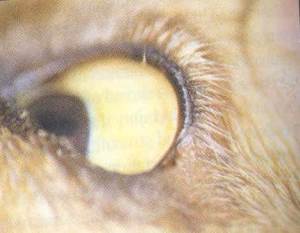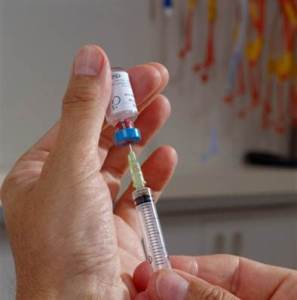
Infectious Canine Hepatitis
A page about infectious canine hepatitis (ICH) in dogs, describing cause, clinical signs, diagnosis and prevention.

Introduction
Infectious canine hepatitis (ICH) is a highly infectious viral disease of dogs which can cause mild signs in some individuals, but may be fatal in others. Whilst vaccination has resulted in a decrease in the incidence of this disease in recent years, pockets of infection still exist, especially where groups of dogs are maintained in close proximity and where there are many non-vaccinated dogs.
Aetiology
Infectious canine hepatitis is caused by canine adenovirus type 1, a virus related to but distinct from canine adenovirus type 2 that contributes to the canine cough complex. Some strains of the virus may be more pathogenic than others.

Epidemiolgoy
Dogs less than one year of age are most commonly affected. However, those animals that have not been vaccinated or have weakened immune systems are also susceptible.
The virus cannot survive easily in the environment and can be killed by most household disinfectants.
The virus is shed in the faeces, urine, blood, saliva, and nasal discharge of infected dogs. Usually taken in orally or inhaled, the virus then infects the liver and kidneys. The incubation period is 4 days to just in excess of one week.

Clinical Signs
Clinical signs vary from mild inapparent disease to severe life-threatening illness including fever, depression, loss of appetite, coughing, and abdominal tenderness, occasionally accompanied by vomiting. Corneal oedema (Blue eye) and signs of liver disease, such as jaundice or hepatic encephalopathy (nervous signs), may also occur. Severe cases can develop haemorrhagic disease (haematomas in mouth or ears) and death can occur as a result of this or the hepatic disease. Chronic blue eye and kidney damage may persist after recovery from the clinical episode.

Diagnosis
Diagnosis can be based on:
- Clinical signs are highly suggestive of this disease though they do not provide a definitive diagnosis
- Viral antigen can be detected by PCR or virus isolation – This test can identify virus in acutely infected animals from a variety of secretions and excretions. The virus is shed in faeces, urine and nasal discharge.
- Serology – A test for antibodies is available. This identifies development of immunity in recovered animals. Animals may die before antibodies develop however.
- Post mortem examination – Unfortunately many animals with infectious canine hepatitis die. Characteristic lesions and histopathology are present in a variety of tissues and provide a definitive diagnosis.

Control
It is essential to vaccinate your dog according to your vet’s recommendations. Pups that are born to vaccinated dams usually have antibodies from their mothers (maternal antibodies) that protect them against infection during the first few weeks of their lives. The pup is in danger after the level of maternal antibodies declines and that is when it should be vaccinated.
The “7 in one” vaccine contains antigens against infectious canine hepatitis (ICH) as well as against some other serious diseases. For further information on disease and vaccination please click here.
There is no specific treatment for ICH, although supportive therapy in the form of intravenous fluids are often given to correct the fluid loss due to vomiting. The best form of protection against this virus is through vaccination. You’ll be pleased to know that there are some vaccines that offer a duration of immunity of three years. Vaccines may only be prescribed by your veterinary practitioner from whom advice must be sought.
